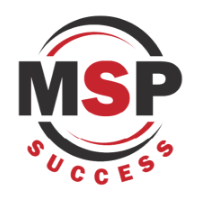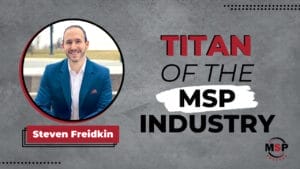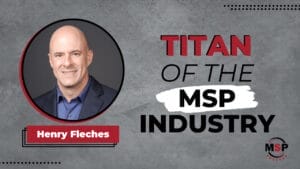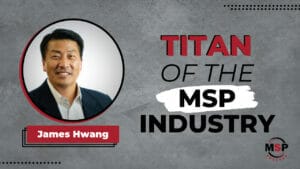The CEO of ITS says it boils down to Cashless Mergers, Remote Work, and Client Education
Note: This article was taken from a live interview and has been edited for length and clarity.
Tom Andrulis ran his MSP, Intelligent Technical Solutions (ITS), for nearly 20 years before he began to wonder if something bigger was possible. After a series of cashless mergers and resounding successes, ITS has tripled in size in just a few years.
Robin Robins, founder of MSP Success, spoke to Tom to figure out what business-savvy secrets were responsible for his success. Any MSP curious about M&A or looking to replicate his rapid growth will benefit from his insider info.
Robin Robins: Can you tell everybody a little bit about your company?
Tom Andrulis: Yeah, thanks for having me. I started ITS in 2003 in Las Vegas. After a few years of figuring out how to run and grow a business, we finally had some success. In 2016, we started putting partnerships together, and we went through a series of about eight different transactions – either acquisitions, mergers or joint venture partnerships. That allowed us to build our company up quickly. Plus, the first eight transactions were all cashless. Rather than spending cash or incurring debt, we figured out very creative ways of putting companies together that were fair for everyone involved. That allowed us to band together and benefit from the synergy of working as one company. Last year, we grew enough that private equity wanted to invest in us, which enabled us to purchase five more MSPs in the last six months or so.
Robin: And from your perspective, what challenges are you seeing in the industry for MSPs of various sizes? How are you overcoming them?
Tom: We’ve tripled in size from 2021 to now. So, the biggest challenge for us at this moment is to organizationally deal with that rapid growth. I believe that people in general take a certain amount of time to absorb change. And we are going through that right now as an organization. The old org structure of 2021 doesn’t work for 2023, not in our world now. There are just too many people. So that’s kind of what we’re dealing with. But I think from a smaller standpoint, there’s a lot of talk about cyber security. At our size, we have the resources and people to keep up with changes in the industry. But if I were a smaller MSP, keeping up would be a lot more challenging. Between cyber security standards changing and M&A happening across the industry, it’s quite a bit to deal with.
Robin: If you were still operating a smaller MSP, what would be your strategy to keep up with those much larger, more operationally mature MSPs?
Tom: I think it all comes down to education. When we went from a break-fix model to a managed services model years ago, we had to go educate our client base to tell them why the old way just wouldn’t cut it anymore. It was no longer their best option, so we showed them a better model and explained how it would benefit them in the long run. The same conversation needs to be had with cyber security. We’re using a completely different tool set so we can detect vulnerabilities and cyber threats. And with that change in tool set, we have to go educate the client base and the community as to why the change is needed. If we can do enough education, then people will start coming around and understanding what this new tool set can do. I think that’s always going to be the strategy every time something changes in the industry.
Robin: Absolutely. And the other challenges in the industry, such as the labor shortage and price increases – how are you handling those?
Tom: We’re tackling those in a couple of different ways. I think raising rates is an important strategy. It allows you to raise the wages of your people so you can stay in lockstep with inflation or where the economy’s going. Years ago, we were scared of raising rates. It’s a scary thing. You have to go to your client and tell them you’ll be charging them 5%, 10% or 15% more. We’ve had some instances where we were so underwater with clients that we had to double, triple or quadruple their rate. That’s a tough conversation. Changing a client’s rate from $4,000 a month to $20,000 a month, that’s tough. But if we don’t have that conversation, we’ll never make the $20,000.
When we initiated that conversation, we explained what was going on and why the rate was changing. The client then has the option to walk away or continue working with us. Many of our clients have been willing to pay the raised rate just to keep working with us. And raising those rates has allowed us to raise the salaries of our staff. Of course, we have to be okay with losing the client when we initiate that conversation. We would never have a conversation like that unless we were willing to walk away.
As far as the labor shortage is concerned, working with people outside the US has been one of our best strategies for combating that. Half of our team is in the Philippines, and we have a few people in different countries outside the Philippines. They’re in every department in the company. That’s a huge strategy we’ve been leaning on for the last 11 years.
Robin: Right. I know hiring technicians is particularly difficult right now. There are more job openings than people to fill them. At a certain point, that begins to prevent you from taking on new clients because you simply don’t have the manpower.
Tom: Using people outside the US helps bridge that gap a little bit. The US has roughly 5% of the world’s population. That means there are 95% more people outside the US. There are hundreds of thousands – if not millions – of people who can help do what we do every day from another country, so why not work with them?
Systems and processes are another massive thing we rely on. If we have to do something over and over again, we’re looking to see if we can automate it. If we can automate it, we’ll write scripts and reports to make it as easy as possible to get that same work done in a fraction of the time. If we can’t automate something, we’ll see if we can do it remotely. If we can do the work remotely, we’ll use remote staff to do that work. If the work needs to be done on-site, then we’ll use a local resource, which is obviously going to be more expensive and harder to find. So that’s how our priority levels work: automate, remote, then local.
Robin: Can you talk a bit more about what automation looks like for you? Are you using AI?
Tom: We’re mostly using ChatGPT for project updates, cleaning up text, marketing blog entries, writing our statement of work and other things like that. Tools like ChatGPT save a lot of time. So, we’ll use tools like that for those tasks, but we use other things as well, such as custom-written software when we need to sift through tickets. But I wouldn’t call ChatGPT artificial intelligence. It’s more like a filtering process to make things easier.
Robin: From your perspective, what do you think the future opportunities are for MSPs, and what should they be putting in place now so they’re ready for what’s coming?
Tom: Cybersecurity is the hottest thing we’ve seen recently. However, there isn’t enough penetration into the marketplace for clients to come to us and ask for it on their own. We get a few leads here and there who will come to us about things like cybersecurity, but for the most part, our clients rely on us to come to them and tell them about the latest trends and what they’ll benefit from.
By and large, we’re the ones educating. We’re the ones building awareness. We’re the ones creating that conversation. Our clients are busy running their own businesses. Unless somebody’s getting hacked, they’re not going to call us and ask to talk about cyber security. Nobody cares about that. They already expect us to keep them safe. So, we have to initiate those conversations.
Robin: Of course. Do you have any advice for MSPs who are considering selling?
Tom: If you’re a smaller MSP – less than $500K of EBITDA or net profit – I think the best thing to do is to try to do either very tiny deals that won’t blow up your small company or partner up or merge with somebody you trust. Maybe that’s someone in your peer group or your current city who you’ve worked with for a while and have a lot of faith in. Partnering up and merging together can help you get to a level where you’re more valuable. If that goes well, then you can find other integrations down the line and keep it going. That’s what we did.
I heard a stat recently that there are about 140 private equity firms that want to be in the MSP space. Seventy of them have platform companies, like ours, that they’ve already invested in. The other 70 are just waiting, still trying to find a platform. The tough part for them is that they need to deploy a certain amount of cash to make it worthwhile for their fund, and they can’t do it unless the company is a certain size, like maybe $4 or $5 million or above. So, from our standpoint in the industry, we need to do whatever we can do to grow, band together, merge or acquire – whatever we have to do to get to that size that makes someone want to invest in us. If we can get to that point, like in our case, people will back us with money and talent. With a little help along the way, we can make this a pretty sizable organization.
Robin: There are a lot of small MSPs that are under $500,000 in EBITDA that might be considering selling. What would your advice be to them? Should they stick with it another three to five years and see where it goes?
Tom: Really, it depends on people’s situations. Some people are so burned out that they just want to focus on something they’re passionate about. So, they’d rather sell or merge into another MSP and focus on what’s important to them. I’ve seen some people who’ve run their business for 30 years, and they’re just ready to be done. It’s not always about the money. A lot of times, it isn’t about the money – it’s about the emotional decision people are making because they’re sick of where they’re at.
But if the company is only worth a few hundred thousand dollars and you’re not completely burned out, my advice is always to keep going. Just keep going. You never know what’s around the corner. There might be the next big deal, the next marketing thing, that new sales tactic. The amount of value that people can build from a small company to a slightly bigger company is just insane. Maybe the company is worth $100,000, right? You do a couple extra things and now the company is worth $300,000 $400,000 or $500,000, and you do a little bit more than that – now it’s worth $1 million. The numbers start adding up very quickly. I think it’s important to gauge where you’re at and make sure you still have the passion for running the business. And if you do, stick it out and see where that passion takes you.






